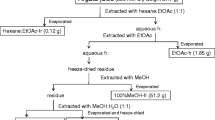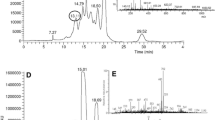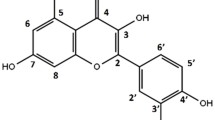Summary
In the Sahelian countries coloquint seed tar is used in traditional medicine. A condensate from the seed of Citrullus colocynthis was obtained in a camel nomad settlement. It contained a large number of polycyclic aromatic hydrocarbons, including known carcinogens [e.g., benzo(a)pyrene, benz(a)anthracene, benzo(b)fluoranthene, benzo(j)fluoranthene]. The dose-related carcinogenic activity of this condensate was established after chronic epicutaneous application to mouse skin. We conclude that the manufacture and use of coloquint tar and related compounds may involve a health hazard and could lead to the development of cancer.
Similar content being viewed by others
References
Eisenbrand G (1981) N-Nitroso-Verbindungen in Nahrung und Umwelt, Wissenschaftliche Verlagsgesellschaft, Stuttgart
Grimmer G (1979) Vorkommen: Zigaretten. In: Luftqualitätskriterien für ausgewählte polyzyklische aromatische Kohlenwasserstoffe. Schmidt, Berlin, pp 70–76 (Umweltbundesamt-Berichte 1/79)
Grimmer G, Böhnke H (1979) Gas chromatographic profile analysis of polycyclic aromatic hydrocarbons in lubrication oil, cutting oil and fuel. In: Environmental carcinogens: selected methods of analysis. International Agency for Cancer Research, Lyons, pp 155–162 (IARC publications no. 29)
Grimmer G, Jacob J, Naujack KW (1981) Profile of the polycyclic aromatic hydrocarbons from lubrication oils: inventory by GCGC/MS-PAH in environmental materials, Part 1. Z Anal Chem 306:347–355
Habs M, Schmähl D (1979) Applikationsort: Haut. In: Luftqualitätskriterien für ausgewählte polyzyklische aromatische Kohlenwasserstoffe. Schmidt, Berlin, pp 191–198 (Umweltbundesamt-Berichte 1/79)
Habs M, Schmähl D, Misfeld J (1980) Local carcinogenicity of some environmentally relevant polycyclic aromatic hydrocarbons after lifelong topical application to mouse skin. Arch Geschwulstforsch 50:266–274
Jahn SA (1981) Traditional water purification in tropical developing countries. Existing methods and potential application. German Agency for Technical Cooperation, Eschborn (Publication series no. 117)
Peto R, Pike MG, Day NE, Gray RG, Lee PN, Parish S, Peto J, Richards S, Wahrendorf J (1980) Guidelines for simple, sensitive significance tests for carcinogenic effects in long-term animal experiments. International Agency for Cancer Research, Lyons, pp 311–426 (IARC monographs evaluating carcinogenic risk of chemicals to Humans, suppl 2)
Author information
Authors and Affiliations
Additional information
Dedicated to Professor Hermann Druckrey on the occasion of his 80th birthday
Rights and permissions
About this article
Cite this article
Habs, M., Jahn, S.A.A. & Schmähl, D. Carcinogenic activity of condensate from coloquint seeds (Citrullus colocynthis) after chronic epicutaneous administration to mice. J Cancer Res Clin Oncol 108, 154–156 (1984). https://doi.org/10.1007/BF00390988
Received:
Accepted:
Issue Date:
DOI: https://doi.org/10.1007/BF00390988




